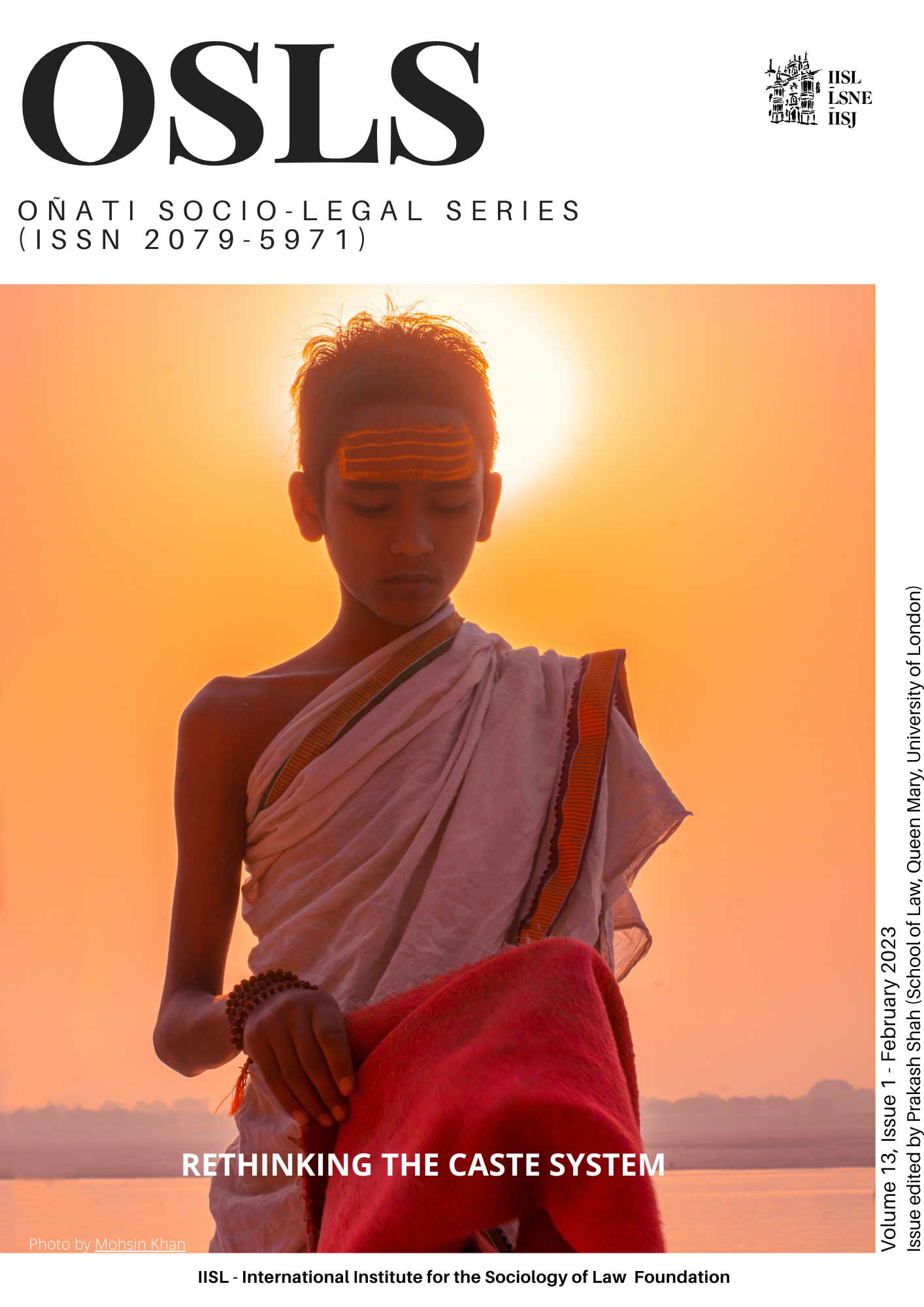On the explanatory adequacy of the Hindutva-as-Brahmanical model
DOI:
https://doi.org/10.35295/osls.iisl/0000-0000-0000-1334Keywords:
Caste, Hindutva, India, casteism, Brahmanism, politics, elections, Sangh Parivar, Bharatiya Janata Party (BJP)Abstract
One of the most significant and confounding anomalies facing experts and commentators is the Hindutva movement’s popularity amongst Dalit and OBC voters. If the Hindutva movement is Brahmanical, how can it be the choice of those it seeks to oppress? This article examines this conundrum. It addresses three central arguments in claims that the movement is Brahmanical, showing how these are based on arbitrary, incomplete data (such as the claim that the Sangh Parivar is against caste-based reservations), or hide conceptual contradictions (such as the argument that the Sangh’s opposition to proselytization is casteist). Furthermore, taken to their logical end, explanations for the movement’s success amongst Dalit and OBC groups raise fundamental questions for/contradictions to the received view on the caste system. This article concludes that describing the Hindutva movement as Brahmanical raises many questions for the received view on the caste system without furthering our understanding of the movement in any way.
Downloads
Metrics
Global Statistics ℹ️
|
1277
Views
|
1550
Downloads
|
|
2827
Total
|
|
References
Abhishek, K., 2019. Dalit leader Mayawati gives maximum seats to Brahmins in Lok Sabha polls. India Today [online], 4 March. Available from: https://www.indiatoday.in/elections/lok-sabha-2019/story/dalit-leader-mayawati-gives-maximum-seats-to-brahmins-in-lok-sabha-polls-1470307-2019-03-04 [Access 2 May 2020].
Adcock, C.S., 2014. Debating Conversion, Silencing Caste: The Limited Scope of Religious Freedom. Journal of Law and Religion [online], 29(3). Available from: https://www.jstor.org/stable/24739112?seq=15#metadata_info_tab_contents [Access 10 April 2021] DOI: https://doi.org/10.1017/jlr.2014.19
Anand, D., 2011. Hindu Nationalism in India and the Politics of Fear. London: Palgrave Macmillan. DOI: https://doi.org/10.1057/9780230339545
Andersen, W.K., and Damle, S.D., 2019a. Messengers of Hindu Nationalism: How the RSS Reshaped India. London: C. Hurst & Co.
Andersen, W.K., and Damle, S.D., 2019b. The Brotherhood in Saffron: The Rashtriya Swayamsevak Sangh and Hindu Revivalism. New York: Penguin Random House.
Anderson, E., and Longkumer, A., 2018. “Neo-Hindutva”: evolving forms, spaces, and expressions of Hindu nationalism. Contemporary South Asia [online], 26(4), 371-377. Available from: https://doi.org/10.1080/09584935.2018.1548576 [Access 2 November 2021]. DOI: https://doi.org/10.1080/09584935.2018.1548576
Ansari, G., 1960. Muslim caste in Uttar Pradesh: A study of culture contact. Lucknow: Ethnographic and Folk Culture Society.
Arora, T., 2020. For 70 years, Dalits have been denied freedom of religion - through a presidential order. Scroll.in [online], 21 August. Available from: https://scroll.in/article/970613/for-70-years-dalits-have-been-denied-freedom-of-religion-through-a-presidential-order [Access 10 December 2021].
Ayyub, R., 2019. India’s crackdown in Kashmir has paralyzed and silenced entire communities. The Washington Post [online], 23 October. Available from: https://www.washingtonpost.com/opinions/2019/10/23/indias-crackdown-kashmir-has-paralyzed-silenced-entire-communities/ [Access 1 July 2022].
Babu, D.S., 2019. From empowerment to disenfranchisement: Lower caste mobilisation appears to have run its course. The Times of India [online], 28 August. Available from: https://timesofindia.indiatimes.com/blogs/toi-edit-page/from-empowerment-to-disenfranchisement-lower-caste-mobilisation-appears-to-have-run-its-course/ [Access 20 July 2020].
Bacchetta, P., 1993. All Our Goddesses Are Armed: Religion, Resistance, and Revenge in the Life of a Militant Hindu Nationalist Woman. Critical Asian Studies, 25(4). DOI: https://doi.org/10.1080/14672715.1993.10416137
Balagangadhara, S.N., 2012. Reconceptualizing India Studies. New Delhi: Oxford University Press.
Bansal, S., 2019. How India voted in 2019 election? Here is what India Today-Axis My India post-poll study tells us. India Today [online], 31 May. Available from: https://www.indiatoday.in/diu/story/how-india-voted-2019-lok-sabha-election-india-today-axis-my-india-poll-1539617-2019-05-31 [Access 15 September 2020].
Basu, A., 1993. Feminism Inverted: The Real Women and Gendered Imagery of Hindu Nationalism. Critical Asian Studies, 25(4), 25–37. DOI: https://doi.org/10.1080/14672715.1993.10416136
Basu, T., et al., 1993. Khaki Shorts and Saffron Flags: A Critique of the Hindu Right. New Delhi: Orient Longman.
Bauman, C.M., and Young, R.F., eds., 2014. Constructing Indian Christianities: culture, conversion and caste. New Delhi: Routledge. DOI: https://doi.org/10.4324/9781315734200
BBC News, 2019. What is India‘s caste system? BBC [online], 19 June. Available from: https://www.bbc.co.uk/news/world-asia-india-35650616 [Access 7 December 2021].
Berg, D.E., 2020. Dynamics of Caste and Law: Dalits, Oppression and Constitutional Democracy in India. Cambridge University Press. DOI: https://doi.org/10.1017/9781108779616
Bhatt, C., and Mukta, P., 2000. Hindutva in the West: mapping the antinomies of diaspora nationalism. Ethnic and Racial Studies [online], 23(3), 407-441. Available from: https://doi.org/10.1080/014198700328935 [Access 15 October 2021]. DOI: https://doi.org/10.1080/014198700328935
Bhatt, C., 2001. Hindu Nationalism: Origins, Ideologies and Modern Myths. Oxford: Berg.
Bryant, E., 2001. The Quest for the Origins of Vedic Culture: The Indo-Aryan Migration Debate. Oxford University Press. DOI: https://doi.org/10.1093/0195137779.001.0001
Cavallin, C., 2020. Leaving Hinduism. In: D. Enstedt, G. Larsson, and T.T. Mantsinen, eds., Handbook of Leaving Religion [online]. Leiden: Brill. Available from: https://doi.org/10.1163/9789004331471_003 [Access 2 April 2021]. DOI: https://doi.org/10.1163/9789004331471_003
Chako, P., 2019. Marketizing Hindutva: The state, society, and markets in Hindu nationalism. Modern Asian Studies [online], 53(2), 377–410. Available from: https://doi.org/10.1017/S0026749X17000051 [Access 1 November 2021]. DOI: https://doi.org/10.1017/S0026749X17000051
Chatterji, A.P., Hansen, T.B., and Jaffrelot, C., eds., 2019. Majoritarian State: How Hindu Nationalism is Changing India. New York: Oxford University Press. DOI: https://doi.org/10.1093/oso/9780190078171.001.0001
Claerhout, S., and De Roover, J., 2005. The Question of Conversion in India. Economic and Political Weekly [online], 40(28), 3048–3055. Available from: http://www.jstor.org/stable/4416875 [Access 1 August 2015].
Claerhout, S., and De Roover, J., 2019. Religious freedom and the limits of propagation: conversion in the constituent assembly of India. Religions [online], 10(3). Available from: http://hdl.handle.net/1854/LU-8604636 [Access 1 October 2021]. DOI: https://doi.org/10.3390/rel10030157
Daniyal, S. 2014. Congress appeasement has never helped minorities. Scroll.in [online], 4 July. Available from: https://scroll.in/article/668775/congress-appeasement-has-never-helped-minorities [Access 20 April 2020].
De Roover, J., 2017. Scheduled Castes vs. Caste Hindus: about a colonial distinction and its legal impact. Socio-Legal Review [online], 13(1), 22–52. Available from: http://hdl.handle.net/1854/LU-8533846 [Access 20 August 2021]. DOI: https://doi.org/10.55496/DLUQ9063
De Roover, J., 2019. A new school in the study of India? Contemporary South Asia [online], 27(2), 273-285. Available from: https://doi.org/10.1080/09584935.2019.1610724 [Access 15 May 2019]. DOI: https://doi.org/10.1080/09584935.2019.1610724
De Roover, J., and Claerhout, S., 2015. The Caste Connection: on the sacred foundations of social hierarchy. Theatrum Historiae [online]. Available from: https://theatrum.upce.cz/index.php/theatrum/article/download/2045/1812 [Access 1 October 2017].
Desai, D., 2007. Mayawati’s Brahmins. The Indian Express [online], 17 March. Available from: http://archive.indianexpress.com/news/mayawati-s-brahmins/25934/ [Access 1 May 2020].
Deshpande, S., 2021. Reservation Debate: a new, post-myth era. The Indian Express [online], 15 March. Available from: https://indianexpress.com/article/
opinion/columns/supreme-court-caste-reservation-ceiling-ews7228318/ [Access 20 March 2021].
Dirks, N.B., 2001. Castes of Mind: Colonialism and the Making of Modern India. Princeton University Press. DOI: https://doi.org/10.1515/9781400840946
Doniger, W., and Nussbaum, M., ed., 2015. Pluralism and Democracy in India: Debating the Hindu Right. New York: Oxford University Press. DOI: https://doi.org/10.1093/acprof:oso/9780195394825.001.0001
Dushkin, L., 1967. Scheduled Caste Policy in India: History, Problems, Prospects. Asian Survey [online], 7(9), 626–36. Available from: https://doi.org/10.2307/2642619 [Access 15 January 2022]. DOI: https://doi.org/10.1525/as.1967.7.9.01p0302f
Fárek, M., et al., eds., 2017. Western Foundations of the Caste System. London: Palgrave Macmillan. DOI: https://doi.org/10.1007/978-3-319-38761-1
Flood, G., ed., 2008. The Blackwell Companion to Hinduism. Oxford/Malden: Wiley.
Forrester, D.B., 2018. Caste and Christianity: Attitudes and policies on caste of Anglo-Saxon Protestant missions in India. London: Routledge. DOI: https://doi.org/10.4324/9781315207919
Graham, B.D., 1990. Hindu Nationalism and Indian Politics: The Origins and Development of the Bharatiya Jana Sangh. New York: Cambridge University Press. DOI: https://doi.org/10.1017/CBO9780511558825
Gudavarthy, A., 2012. Can We De-Stigmatise Reservations in India? Economic and Political Weekly [online], 47 (6). Available from: https://www.epw.in/
journal/2012/06/special-articles/can-we-de-stigmatise-reservations-india.html [Access 15 October 2021].
Gudavarthy, A., 2019. The Crisis in Dalit-Bahujan politics. The Hindu [online], 4 November. Available from: https://www.thehindu.com/opinion/lead/the-crisis-in-dalit-bahujan-politics/article29872372.ece [Access 15 October 2021].
Guldner, B., 1908. Conversion. The Catholic Encyclopedia. New York: Robert Appleton Company.
Guru, G., 2017. Dalit Middle Class Hangs in the Air. In: I. Ahmad and H. Reifeld, eds., Middle-Class Values in India and Western Europe. London: Routledge. DOI: https://doi.org/10.4324/9781315144900-10
Guru, G., ed., 2005. Atrophy in Dalit Politics. Mumbai: Vikas Adhyayan Kendra.
Hansen, T.B., 1999. The Saffron Wave: Democracy and Hindu Nationalism in Modern India. Princeton University Press. DOI: https://doi.org/10.1515/9781400823055
Hasan, Z., 1993. Communalism State Policy and the Question of Women‘s Rights in Contemporary India. Critical Asian Studies, 25(4), 5–15. DOI: https://doi.org/10.1080/14672715.1993.10416134
Jaffrelot, C., 2021. Modi’s India: Hindu Nationalism and the Rise of Ethnic Democracy. Princeton University Press. DOI: https://doi.org/10.1515/9780691223094
Jaffrelot, C., ed., 2007. Hindu Nationalism: A Reader. Princeton University Press. DOI: https://doi.org/10.1515/9781400828036
Jha, P., and Jha, P., 2019. Article 370 and The Paradox of Kashmir’s Accession. The Wire [online], 21 September. Available from: https://thewire.in/government/article-370-and-the-paradox-of-kashmirs-accession [Access 1 July 2022].
Jodhka, S.S., 2012. Caste. New Delhi: Oxford University Press. DOI: https://doi.org/10.1093/obo/9780199756384-0006
Kaushal, D., 2007. RSS Resolves: 1950-2007. New Delhi: Suruchi Prakashan.
Keppens, M., and De Roover, J., 2014. Orientalism and the puzzle of the Aryan invasion theory. Pragmata: Journal of Human Sciences [online], 2(2), 51–76. Available from: http://hdl.handle.net/1854/LU-5845673 [Access 15 September 2016].
Keppens, M., and De Roover, J., 2020. The Brahmin, the Aryan, and the powers of the priestly class: puzzles in the study of Indian religion. Religions [online], 11(4). Available from: https://doi.org/10.3390/rel11040181 [Access 1 November 2021]. DOI: https://doi.org/10.3390/rel11040181
Khapre, S., 2021. Explained: How Marathas got reservation, and what happens now. The Indian Express [online], 11 May. Available from: https://indianexpress.com/
article/explainned/explained-how-marathas-got-reservation-and-what-happens-now-7303056/ [Access 2 December 2021].
Kopf, D., 2015. The Brahmo Samaj and the Shaping of the Modern Indian Mind. Princeton University Press. DOI: https://doi.org/10.1515/9781400869893
Kumar, S., and Gupta, P., 2019. Where did the BJP get its votes from in 2019? Mint [online], 3 June. Available from: https://www.livemint.com/politics/news/where-did-the-bjp-get-its-votes-from-in-2019-1559547933995.html [Access 15 September 2020].
Louis, P., 2000. The Emerging Hindutva Force: The Ascent of Hindu Nationalism. Delhi: Indian Social Institute.
Menon, K.D., 2010. Everyday Nationalism: Women of the Hindu Right in India. Philadelphia: University of Pennsylvania Press. DOI: https://doi.org/10.9783/9780812202793
Mitul, M., 2018. Word “Dalit” has its Origin in Gandhi and Ambedkar’s Poona Pact. News18 [online], 5 June. Available from: https://www.news18.com/news/
india/word-dalit-has-political-and-cultural-context-intellectuals-weigh-in-on-ministrys-advisory-1867913.html [Access 1 July 2022].
Mosse, D., 2020. Outside Caste? The Enclosure of Caste and Claims to Castelessness in India and the United Kingdom. Comparative Studies in Society and History [online], 62(1), 4–34. Available from: https://doi.org/10.1017/S0010417519000392 [Access 15 August 2021]. DOI: https://doi.org/10.1017/S0010417519000392
Mukherjee, K., 2007. Indian Hindu outcasts convert to end social stigmas. Reuters [online], 19 January. Available from: https://www.reuters.com/article/us-religion-india-conversion/indian-hindu-outcasts-convert-to-end-social-stigmas-idUSSP26345320061031 [Access 15 April 2020].
Naqvi, S., 2019. The Return of the Brahmin? The Citizen [online], 16 March. Available from: https://www.thecitizen.in/index.php/en/NewsDetail/index/4/16487/The-Return-Of-The-Brahmin [Access 29 May 2020].
Narayan, B., 2009. Fascinating Hindutva: Saffron Politics and Dalit Mobilisation. New Delhi: Sage. DOI: https://doi.org/10.4135/9788132101055
Narayan, B., 2021. Republic of Hindutva: How the Sangh is Reshaping Indian Democracy. New York: Penguin Random House.
Nussbaum, M., 2008. The Clash Within: Democracy, Religious Violence, and India’s Future. Cambridge, MA: Harvard University Press. DOI: https://doi.org/10.4159/9780674041561
Prathvi Raj Chauhan v Union of India & Ors (2018) Writ Petition [C] No. 1016 [online]. Available from: https://main.sci.gov.in/supremecourt/2018/
/31176_2018_3_1501_20551_Judgement_10-Feb-2020.pdf [Access 29 November 2021].
Press Trust of India, 2019. “Article 370 Scrapped As J&K Is a Muslim-Dominated State”: P. Chidambaram. NDTV [online], 12 August. Available from: https://www.ndtv.com/india-news/p-chidambaram-says-article-370-scrapped-as-j-k-is-a-muslim-dominated-state-2083966 [Access 1 July 2022].
Rao, M., 2018. Ground report: A wall in a TN village stands for the divide between 2 scheduled castes. The News Minute [online], 20 February. Available from: https://www.thenewsminute.com/article/ground-report-wall-tn-village-stands-divide-between-2-scheduled-castes-76752 [Access 3 January 2022].
Salam, Z.U., 2018. Of Saffron Flags and Skullcaps: Hindutva, Muslim Identity and the Idea of India. New Delhi: Sage.
Sarkar, T., 1999. Pragmatics of the Hindu Right: Politics of Women’s Organisations. Economic and Political Weekly [online], 34(31), 2159–2167. Available from: http://www.jstor.org/stable/4408263 [Access 1 July 2018].
Shani, O., 2007. Communalism, Caste and Hindu Nationalism: The Violence in Gujarat. New York: Cambridge University Press. DOI: https://doi.org/10.1017/CBO9780511607936
Sharma, A., 2005. Dr. B. R. Ambedkar on the Aryan Invasion and the Emergence of the Caste System in India. Journal of the American Academy of Religion [online], 73(3), 843–870. Available from: http://www.jstor.org/stable/4139922 [Access 10 November 2021]. DOI: https://doi.org/10.1093/jaarel/lfi081
Shepherd, K.I., 2019a. Gandhi was not a caste abolitionist. The Week [online], 22 June. Available from: https://www.theweek.in/theweek/cover/2019/06/21/gandhi-was-not-a-caste-abolitionist-kancha-ilaiah-shepherd.html [Access 10 May 2020].
Shepherd, K.I., 2019b. The Hardworking Chowkidar and the Harvard Brahmin. The Wire [online], 8 April. Available from: https://thewire.in/politics/chowkidar-brahmin-modi-subramanian-swamy-bjp [Access 20 July 2020].
Sibal, K., 2021. Caste and the implementation of reservation. The New Indian Express [online], 27 September. Available from: https://www.newindianexpress.
com/opinions/2021/sep/27/caste-and-the-implementation-of-reservation-2364089.html [Access 2 December 2021].
Singh, A.P., 2019. The Twin crisis of Dalit politics and Dalit discourse. Hindustan Times [online], 27 December, Analysis. Available from: https://www.hindustantimes.
com/analysis/the-twin-crisis-of-dalit-politics-and-dalit-discourse/story-zQBDM8I7QovbHCiiN5LfSP.html [Access 1 March 2020].
Singh, G., 2019. Hindu nationalism in power: Making sense of Modi and the BJP-led National Democratic Alliance government, 2014–19. Sikh Formations [online], 15 (3-4). Available from: https://doi.org/10.1080/17448727.2019.1630220 [Access 10 December 2021]. DOI: https://doi.org/10.1080/17448727.2019.1630220
Sitapati, V., 2017. Reservations. In: S. Choudhary, M. Khosla and P.B. Mehta, eds., The Oxford handbook of the Indian Constitution. Oxford University Press. DOI: https://doi.org/10.1093/law/9780198704898.003.0040
Srinivas, M.N., 1997. The Remembered Village. Oakland: University of California Press.
Srinivas, M.N., 2003. An Obituary on Caste as a System. Economic and Political Weekly [online], 38(5), 455–459. Available from: http://www.jstor.org/stable/4413162 [Access 1 November 2021]. DOI: https://doi.org/10.1023/A:1023935731784
Subramanian, A., 2019. The Caste of Merit: Engineering Education in India. Cambridge, MA: Harvard University Press. DOI: https://doi.org/10.4159/9780674243477
Subramanian, S., 2020. How Hindu Supremacists are tearing India apart. The Guardian [online], 20 February. Available from: https://www.theguardian.com/world/
/feb/20/hindu-supremacists-nationalism-tearing-india-apart-modi-bjp-rss-jnu-attacks [Access 1 July 2020].
Teltumbde, A., 2015. Ghar Wapsi: Welcome to the Hellhole of Hinduism. Economic and Political Weekly [online], 50(1). Available from: https://www.jstor.org/stable/
?read-now=1&refreqid=excelsior:a374dba14033e99d6c1868d93
ef2f962&seq=1#page_scan_tab_contents [Access 25 April 2021].
Teltumbde, A., 2020a. Dalits: Past, Present and Future. Delhi: Taylor & Francis. DOI: https://doi.org/10.4324/9781003030300
Teltumbde, A., ed., 2020b. Hindutva and Dalits: Perspectives for Understanding Communal Praxis. New Delhi: Sage.
Thapar, R., 2003. Cultural Pasts: Essays in Early Indian History. Noida: Oxford University Press.
Tharoor, S., 2015. Why India needs a new debate on caste quotas. BBC [online], 29 August. Available from: https://www.bbc.co.uk/news/world-asia-india-34082770 [Access 2 Dec 2021]
Tharoor, S., 2021. The Struggle for India’s Soul: Nationalism and the Fate of Democracy. London: C. Hurst & Co.
Therwath, I., 2012. Cyber-hindutva: Hindu nationalism, the diaspora and the Web. Social Science Information [online], 51(4). Available from: https://doi.org/10.1177/0539018412456782 [Access 10 June 2016]. DOI: https://doi.org/10.1177/0539018412456782
Van Der Veer, P., 2003. Religious nationalism Hindus and Muslims in India. Berkeley: University of California Press.
Vincent, V., 2021. Is religious conversion a criminal issue? The Hindu [online], 5 December. Available from: https://www.thehindu.com/opinion/open-page/is-religious-conversion-a-criminal-issue/article37838813.ece [Access 15 December 2021].
Vishwanath, R., 2014. The Pariah Problem. New York: Columbia University Press.
Wilkerson, I., 2020. Caste: The Lies That Divide Us. London: Penguin Books.
Zavos, J., 1999. The Ārya Samāj and the Antecedents of Hindu Nationalism. International Journal of Hindu Studies [online], 3(1), 57–81. Available from: http://www.jstor.org/stable/20106628 [Access 17 November 2015]. DOI: https://doi.org/10.1007/s11407-999-0008-x
Published
How to Cite
Issue
Section
License
Copyright (c) 2022 Garima Raghuvanshy

This work is licensed under a Creative Commons Attribution-NonCommercial-NoDerivatives 4.0 International License.
OSLS strictly respects intellectual property rights and it is our policy that the author retains copyright, and articles are made available under a Creative Commons licence. The Creative Commons Non-Commercial Attribution No-Derivatives licence is our default licence and it regulates how others can use your work. Further details available at https://creativecommons.org/licenses/by-nc-nd/4.0 If this is not acceptable to you, please contact us.
The non-exclusive permission you grant to us includes the rights to disseminate the bibliographic details of the article, including the abstract supplied by you, and to authorise others, including bibliographic databases, indexing and contents alerting services, to copy and communicate these details.
For information on how to share and store your own article at each stage of production from submission to final publication, please read our Self-Archiving and Sharing policy.
The Copyright Notice showing the author and co-authors, and the Creative Commons license will be displayed on the article, and you must agree to this as part of the submission process. Please ensure that all co-authors are properly attributed and that they understand and accept these terms.






















